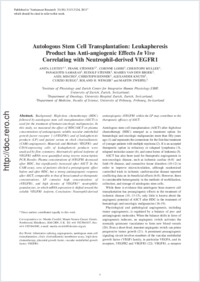Autologous stem cell transplantation: leukapheresis product has anti-angiogenic effects in vivo correlating with neutrophil-derived VEGFR1
- Luethy, Anita Institute of Physiology and Zurich Center for Integrative Human Physiology, University of Zurich, Switzerland
- Stenner, Frank Department of Oncology, University Hospital Zurich, Switzerland
- Lohri, Corinne Department of Oncology, University Hospital Zurich, Switzerland
- Muller, Christoph Institute of Physiology and Zurich Center for Integrative Human Physiology, University of Zurich, Switzerland
- Samaras, Panagiotis Department of Oncology, University Hospital Zurich, Switzerland
- Steiner, Rudolf Department of Oncology, University Hospital Zurich, Switzerland
- Broek, Maries Van Den Department of Oncology, University Hospital Zurich, Switzerland
- Mischo, Axel Department of Oncology, University Hospital Zurich, Switzerland
- Renner, Christoph Department of Oncology, University Hospital Zurich, Switzerland
- Knuth, Alexander Department of Oncology, University Hospital Zurich, Switzerland
- Rüegg, Curzio Department of Medicine, Faculty of Science, University of Fribourg, Switzerland
- Wenger, Roland H. Institute of Physiology and Zurich Center for Integrative Human Physiology, University of Zurich, Switzerland
- Zweifel, Martin Department of Oncology, University Hospital Zurich, Switzerland
-
2011
Published in:
- Anticancer Research. - 2011, vol. 31, no. 10, p. 3115-3124
Alternative splicing
angiogenesis
autologous stem cell transplantation
chick chorioallantoic membrane assay
high-dose chemotherapy
placental growth factor
vascular endothelial growth factor
VEGFR1
English
Background: High-dose chemotherapy (HDC) followed by autologous stem cell transplantation (ASCT) is used for the treatment of hemato-oncologic malignancies. In this study, we measured the effect of HDC/ASCT on plasma concentrations of antiangiogenic soluble vascular endothelial growth factor receptor 1 (sVEGFR1) and of leukapheresis products (LP) and patient serum on chick chorioallantoic (CAM) angiogenesis. Materials and Methods: VEGFR1- and CD34-expressing cells of leukapheresis products were analyzed by flow cytometry. Alternatively spliced isoforms of VEGFR1 mRNA were quantified using reverse transcription PCR. Results: Plasma concentrations of sVEGFR1 decreased after HDC, but significantly increased after ASCT. In the CAM assay, sera of patients elicited a proangiogenic effect before and after HDC, but a strong antiangiogenic response after ASCT, comparable to that of bevacizumab at therapeutic concentrations. LP contains high concentrations of sVEGFR1, and high density of VEGFR1+ neutrophilic granulocytes, in which mRNA expression is shifted toward the soluble VEGFR1 isoform. Conclusion: Neutrophil- derived antiangiogenic sVEGFR1 within the LP may contribute to the therapeutic efficacy of ASCT.
- Faculty
- Faculté des sciences et de médecine
- Department
- Médecine 3ème année
- Language
-
- English
- Classification
- Biological sciences
- Other electronic version
- License
- License undefined
- Identifiers
-
- RERO DOC 28471
- Persistent URL
- https://folia.unifr.ch/unifr/documents/302469
Statistics
Document views: 61
File downloads:
- rue_acs.pdf: 147
